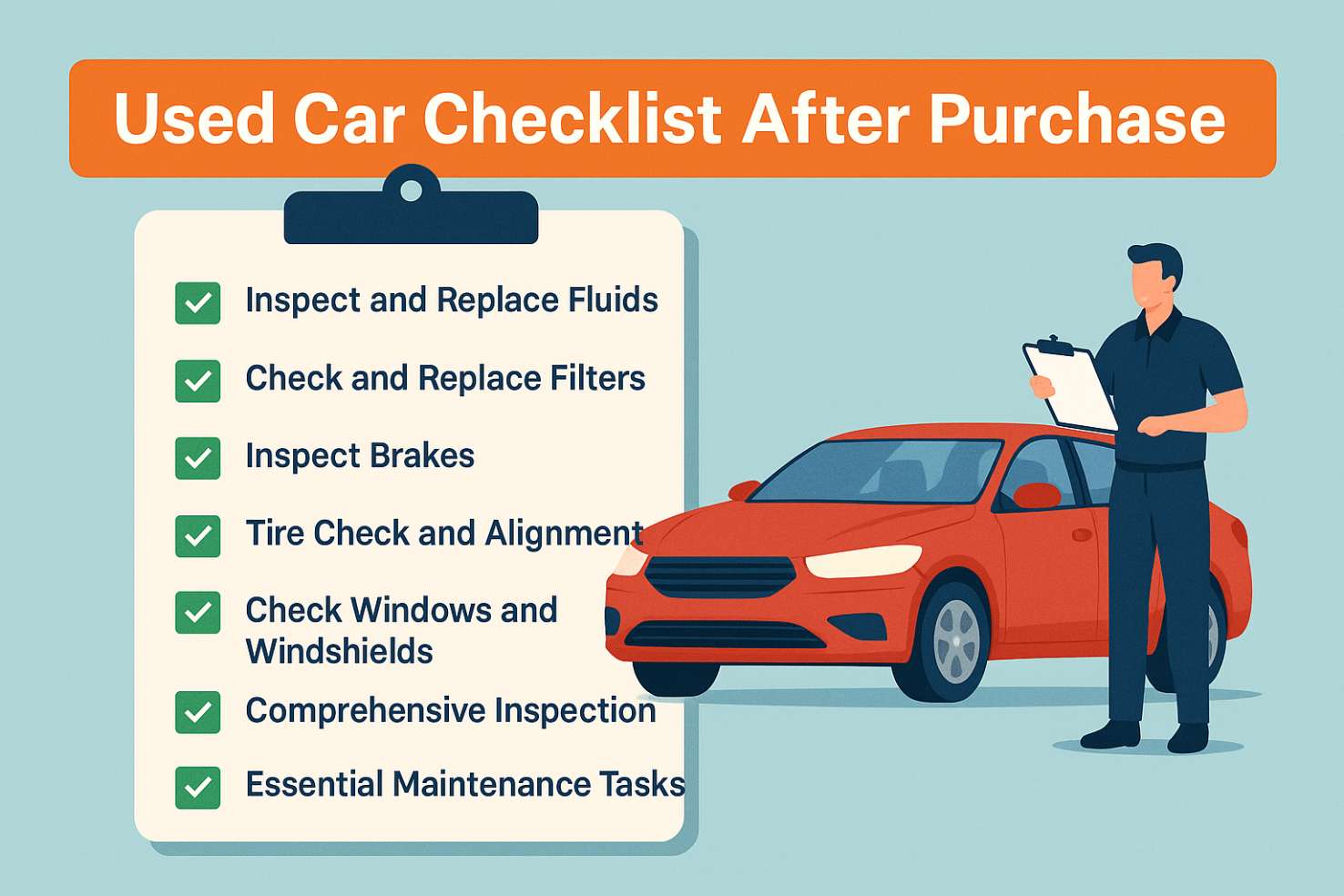Congratulations on your used car purchase! Finding the right vehicle at the right price is a win, but there’s more to do. The first weeks of ownership are key for spotting issues and handling maintenance. Taking proactive steps now can save you money and keep your car running smoothly. This guide covers essential tasks to help you get the most from your investment.

Inspect and Replace Fluids
Your car’s fluids are its lifeblood, and used vehicles often come with fluids of unknown age and quality. Start with a complete fluid inspection and replacement schedule.
Engine Oil and Filter
Check your oil level and color immediately. Dark, gritty oil needs immediate replacement, regardless of when the previous owner claims it was last changed. Fresh oil protects your engine’s moving parts and can reveal potential problems through metal particles or unusual debris.
Schedule an oil change within the first week of ownership, using the manufacturer-recommended viscosity. This gives you a clean baseline and removes any doubts about oil quality.
Coolant System
Examine the coolant reservoir for proper levels and color. Coolant should be bright green, orange, or pink—never brown or rusty. Old coolant loses its ability to prevent corrosion and regulate temperature, potentially leading to expensive engine damage.
Flush and replace the coolant if it appears contaminated or if you can’t verify its age. This is especially important for vehicles over five years old.
Brake and Transmission Fluids
Brake fluid should be clear or light yellow, never dark brown or black. Contaminated brake fluid compromises your stopping power and can damage brake components. Similarly, transmission fluid should be red or pink with a sweet smell. Dark, burnt-smelling fluid indicates potential transmission problems.
Both fluids are critical for safety and should be replaced immediately if they show signs of contamination.
Check and Replace Filters
Filters protect your engine and cabin air quality, but they’re often neglected by previous owners. A complete filter replacement is an inexpensive way to improve performance and prevent future problems.
Air Filter
A clogged air filter reduces fuel economy and engine performance. Remove the air filter and hold it up to light—if you can’t see through it clearly, replace it. This simple $20 fix can improve gas mileage by up to 10%.
Cabin Air Filter
The cabin air filter affects your heating and air conditioning system’s efficiency and your interior air quality. A dirty filter forces your climate control system to work harder and can allow allergens and pollutants into the passenger compartment.
Most cabin filters are located behind the glove compartment and are easy to replace yourself.
Fuel Filter
While not all vehicles have user-replaceable fuel filters, those that do benefit from regular replacement. A clogged fuel filter can cause poor acceleration, engine hesitation, and reduced fuel economy.
Inspect Brakes
Your braking system deserves immediate attention since it directly affects your safety. A thorough brake inspection should cover all major components.
Brake Pads and Rotors
Look through your wheel spokes to visually inspect brake pads. Most pads have wear indicators that create a squealing sound when replacement is needed. If the pad material appears less than a quarter-inch thick, schedule replacement immediately.
Check rotors for scoring, warping, or excessive rust. Damaged rotors can cause vibration during braking and reduce stopping power.
Brake Lines and Fluid
Inspect brake lines for leaks, corrosion, or damage. Pay special attention to connection points and areas where lines pass near the exhaust system. Any signs of brake fluid leaks require immediate professional attention.
Test your brakes in a safe environment to identify any unusual noises, vibrations, or pulling to one side.
Tire Check and Alignment
Tires are your connection to the road, making their condition critical for safety and performance. Beyond basic tread depth, several factors affect tire performance and longevity.
Tire Condition and Pressure
Check tread depth using the penny test—insert a penny into the tread with Lincoln’s head upside down. If you can see the top of Lincoln’s head, the tire needs replacement. Also look for uneven wear patterns, which indicate alignment issues, suspension problems, or improper inflation.
Verify that all tires match in brand, size, and approximate age. Mismatched tires can affect handling and put additional stress on your drivetrain.
Wheel Alignment
Poor alignment causes premature tire wear and affects vehicle handling. Signs include the steering wheel being off-center when driving straight, the car pulling to one side, or uneven tire wear patterns.
Professional alignment service typically costs $100-200 but can extend tire life significantly and improve fuel economy.
Check Windows and Windshields
Inspect all glass surfaces for chips, cracks, or other damage that could compromise visibility or safety. Small chips can quickly spread into large cracks, especially with temperature changes or road vibrations.
Pay particular attention to your windshield, as even minor damage can become a safety hazard. If you notice any cracks or chips larger than a quarter, consider windshield replacement, like those available in Tooele, to ensure optimal visibility and structural integrity. Many insurance policies cover glass repair or replacement with minimal deductibles.
Check that all windows operate smoothly and that seals are intact to prevent water leaks and wind noise.
Comprehensive Inspection
Beyond specific systems, a thorough overall inspection can reveal hidden issues that might not be immediately apparent.
Belts and Hoses
Examine belts for cracking, fraying, or stretching. A broken serpentine belt can disable multiple systems simultaneously, including your alternator, power steering, and air conditioning.
Check hoses for bulging, cracking, or soft spots. Cooling system hoses are particularly important, as failure can lead to engine overheating and costly damage.
Battery and Electrical System
Test your battery’s condition and check connections for corrosion. Most auto parts stores offer free battery testing. A weak battery can leave you stranded and may indicate charging system problems.
Verify that all lights, signals, and electrical accessories function properly. Electrical issues can be expensive to diagnose and repair if left unaddressed.
Suspension and Steering
Listen for unusual noises when turning or going over bumps. Check for excessive play in the steering wheel or vibrations that could indicate worn suspension components.
Walk around your parked car to ensure it sits level. A vehicle that leans to one side may have suspension problems or uneven tire pressure.
Essential Maintenance Tasks
Create a maintenance schedule based on your vehicle’s age, mileage, and service history. Some tasks require immediate attention, while others can be planned for the coming months.
Timing Belt
If your vehicle has a timing belt (rather than a chain), verify when it was last replaced. Timing belt failure can cause catastrophic engine damage in interference engines. Most timing belts need replacement every 60,000-100,000 miles.
Spark Plugs and Ignition System
Worn spark plugs reduce fuel economy and can cause engine misfires. Most modern vehicles use long-life plugs that last 60,000-100,000 miles, but older vehicles may need replacement every 30,000 miles.
Drive Belts and Pulleys
Inspect accessory drive belts and their pulleys for proper alignment and wear. Squealing noises during startup often indicate belt problems that should be addressed promptly.
Conclusion
Investing in proper maintenance now saves you from costly repairs later. Focus on safety items like brakes, tires, and lights, and keep up with fluid changes and filter replacements. Track your work in a maintenance log and build a relationship with a trusted mechanic for complex inspections. A little effort now ensures your used car stays reliable, safe, and valuable for years to come.

